Autistic children experience the world differently, including how they process sensory information.
Here we’ll discuss the benefits of sensory play activities for autism and what you can do with your autistic foster child at home to ensure they’re stimulated, engaged and having fun while learning!
What is sensory play for autism?
Sensory play involves games and activities that stimulate the 5 senses: sound, sight, smell, taste and touch. This is particularly important for children with autism spectrum disorder (ASD) who often struggle processing sensory information, as they may be extremely sensitive to certain sounds or find bright lights distressing, for example.
Sensory activities for autism are effective learning tools that engage all areas of a child’s brain, helping them with their cognitive, emotional, physical, social and communication development. For autistic children, engaging in sensory play can retrain the brain’s response to sensory information. This helps them cope better when dealing with different sounds, textures, lights, scents and taste.
The benefits of sensory activities for individuals with autism
All young children can benefit from sensory play, but there’s a particular importance of sensory activities for autism diagnosed children. Those with autism struggle to regulate their responses to sensory information, so upon hearing a loud bang or when given an unfamiliar texture, it can be extremely distressing and overwhelming for them.
Not only are sensory activities calming for people with ASD, but they have a huge impact on a child’s development. If you’re fostering autistic children, here are the main benefits of sensory play.
- It stimulates the brain. When a child engages in sensory play sessions, more neural pathways are created. This helps improve the way they process sensory information.
- It helps develop language skills. When you play, you often talk about what you’re doing, create dialogue for imaginary roleplay or express your emotions through laughter and sound. This helps autistic children with their communication skills, even those who are non-verbal.
- It improves social skills. As well as creating imaginary worlds, children learn a lot of social skills through sharing, taking turns and listening to others.
- It improves coordination and fine/gross motor skills. Jumping, running, throwing as well as handling small objects can help children with disabilities strengthen their muscles and improve hand-eye coordination.
- It helps them self-regulate. Over time, sensory play helps children with autism learn how to respond to sensory stimulation in more positive ways, which boosts their self-control.
And last but certainly not least – it’s fun! Play is the natural way for kids to communicate, learn and understand the world and their environment. When you’re fostering a child with disabilities, playtime is essential. It boosts creativity, imagination, problem and conflict solving skills and teaches children about relationship dynamics.


Autism Support Pack for Foster Parents
Download the FCA’s Autism Support Pack. Learn more about the common misconceptions made about children with ASD and how to adapt your home and surroundings to children with autism.
10 sensory activities for children with ASD
When you’re fostering a child with autism, it’s important to understand what sensory information triggers them, both indoors and outside. You can then trial different activities to see which ones they’re comfortable engaging with. Some games may suit one autistic child but not another, so it’s all about learning what’s right for the autistic children in your care so you can help them thrive.
These sensory play activities for autism are super fun, and if your foster child is okay with it, we say get the whole household involved! Whatever age you are, you’re bound to have fun bonding with your foster child through these sensory play activities for autism.
1. Finger painting and footprint painting
Things might get messy, but don’t let that put you off as this a great way for kids to express themselves. Just set some paper out on top of newspaper or tarpaulin and let your foster children create paintings using their hands and feet.
2. Make your own slime
Mix together cornflour and water in a bowl and watch as it shifts from solid to liquid as you play with it. Add in food colourings and glitter for a super sensory experience.
3. Scented playdough
Add things like lemon juice, vanilla extract, cinnamon, peppermint flavouring etc to separate batches of playdough and get them to guess the scents. Just make sure they don’t eat it!
4. Mud kitchen
For outdoor sensory activities for autism, mud kitchens are a popular choice. It’s an area where children can experiment, improvise and create using mud, water, bowls and various utensils. Some children might pretend to bake cakes or cook dinner, whereas others might just enjoy mashing, scooping and manipulating the mud into different shapes.
5. Make your own musical instruments
Put rice inside a plastic bottle to make a shaker; use wooden spoons and buckets for a homemade drum set; put holes in a straw to fashion your own recorder…the ideas are endless!
6. Create a sensory ocean
Fill a shallow storage container with sand on one side and water on the other, and include things like shells, toy fish and other ocean inspired items. Your autistic foster children will enjoy splashing the water, swirling the sand and playing in their new underwater world.
7. Painting with food
Edible sensory activities for autism are great as there’s no harm if your foster child puts their hands in their mouth. Choose soft and squishy foods like chocolate sauce, blackberries, apple puree and yoghurt and let them create a piece of art that looks, smells and tastes amazing!
8. Water beads
Water beads are non-toxic and feel so satisfying to squidge in your hand. Why not put half in the fridge to create a contrast between cold and warm?
9. Toys in jelly
This is another edible sensory activity that involves hiding toys inside bowls of jelly. Place toys into different jelly moulds, pour the jelly solution in and chill in the fridge. Children need to get the toys out of the soft, wobbly jelly anyway they can.
10. Pouring station
This is something that can be set up in minutes. Pour water into different size bottles, jugs, cups and containers and set them up in a bathtub or on a large tray. Add food colouring to enhance the experience. The idea is to get children to pour water from one jug to another, mixing colours and also learning fine motor skills at the same time.
For helpful autism resources and more information about how to foster a child with autism, download our Autism Support Pack for Foster Parents. Or, you can get in touch and we’ll be happy to answer any questions you have.